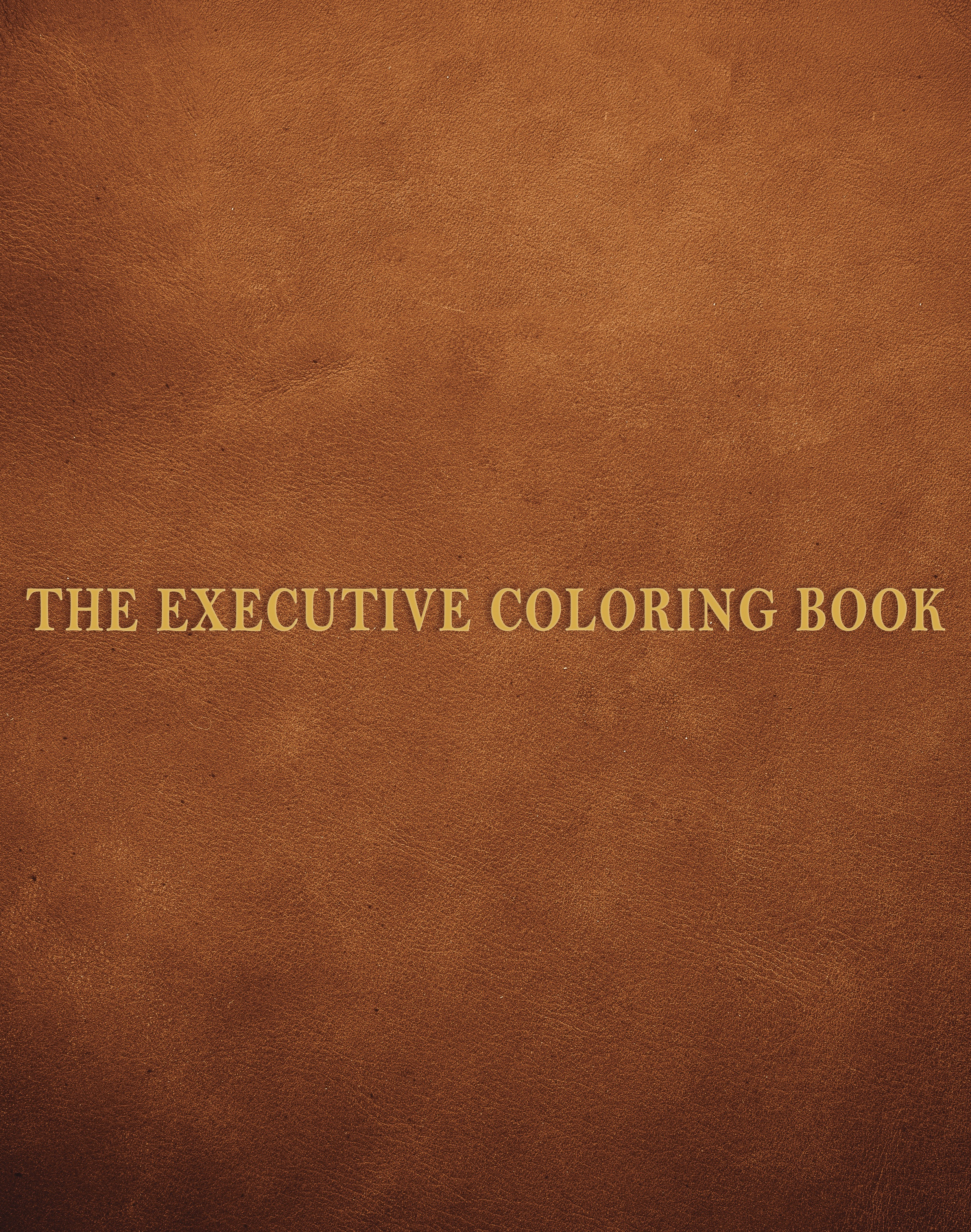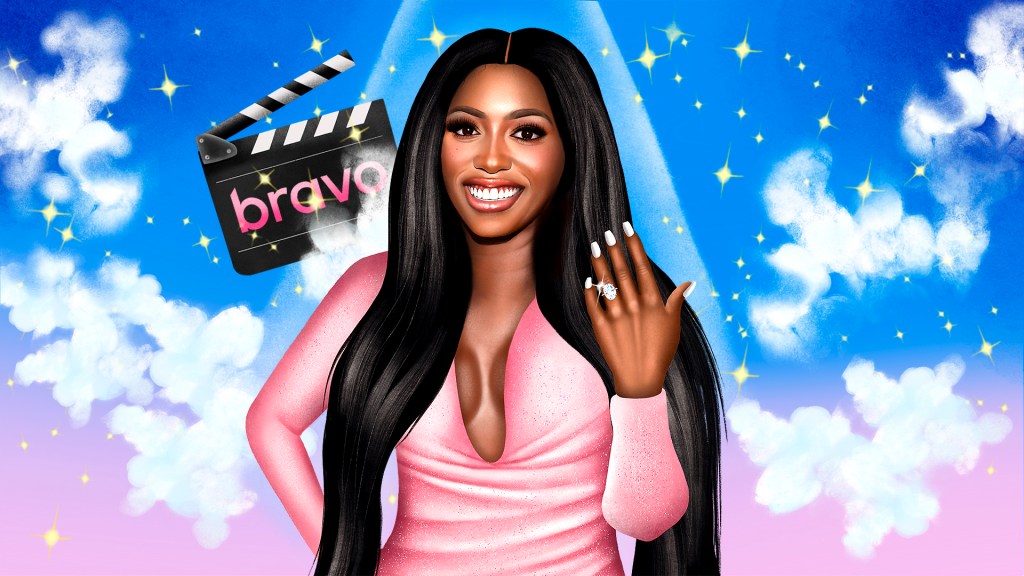In 1955, Harold and the Purple Crayon, a children’s book about a four-year-old and his titular instrument, promised kids a world of unbridled creative potential, an infinitely flexible reality produced from their imaginations. Six years later, three ad executives in Chicago offered a counterpoint with The Executive Coloring Book, a dispatch from the adult world that offered bleak instructions like, “This is my suit. Color it gray or I will lose my job.” This was a coloring book, but one that eschewed innocence for the corporate hamster wheel and landscapes of elevators, sales charts, and company cars. Even the odd dash of color was grim: pink for the pill that “makes me not care,” and mahogany deskware (“I wish I were mahogany”).

From THE EXECUTIVE COLORING BOOK by Marcie Hans, Dennis Altman and Martin A. Cohen, published by G. P. Putnam’s Sons, an imprint of Penguin Publishing Group, a division of Penguin Random House, LLC. Copyright © 2017 by Marcie Hans, Dennis Altman and Martin A. Cohen
Written by—and dedicated to—Marcia Hans, Martin A. Cohen, and Dennis Altman, The Executive Coloring Book is an artifact from the Mad Men era that also has the distinction of being the first adult coloring book. Since then, coloring books for grown-ups have become a fad—over 24 million of these books were sold in the last two years alone. Titles have included Die Hard: The Authorized Color and Activity Book, Color Your Own Dutch Masters, and the Cunt Coloring Book from houses as prestigious as HarperCollins and artists like Tony Millionaire (David Bowie: Color the Starman). These books mostly have a twee, feel-good Punky Brewster sort of vibe. A cult of the eternal child, in other words.
Videos by VICE
It’s far cry from Altman and company, whose books really were for adults: After the unexpected success of The Executive Coloring Book, which sold out its initial run and made the New York Times bestseller list, they followed with The John Birch Society Coloring Book in 1962. Dennis Altman would go on to write a book about Jesus Christ entitled The First Liberal as well as hilariously partisan pop-culture novelties like Meanie Manifesto: The Official Train Manual for Republican Children and one more coloring book, this one about the Koch Brothers.
Now that Penguin is reissuing The Executive Coloring Book (the title is embossed in gold across in a nondescript binding), I recently corresponded with Altman, who is his 80s, about the original activity book for broken middle-class shills and what it feels like to be at the forefront of a cult of pastels.

VICE: Just as a document, I see The Executive Coloring Book as tapping into the corporate estrangement that was a major theme in late 50s novels like The Man In the Grey Flannel Suit or films like The Apartment. Can you say a little bit about where it came from?
Dennis Altman: I was a member of the creative department at North Advertising in Chicago, a lifetime ago—the people who write and design ads and TV spots. We had just come out of a presentation where we showed a new commercial to two guys best known as Steve Stunted and Harlow Halfshot, the group managers on our Frozen Pizza account. (The names have been changed, to protect the incoherent.)
The strategy for the spot was just to say that the pizza tastes great. Simple enough. All the scenes were full of appetite appeal. The product looked delicious, and the people on screen savored every bite. But Steve and Harlow rejected it. I asked why, and they said there weren’t enough adjectives. Steve claimed he had a book that said there had to be at least five descriptive adjectives in every commercial. Contrary to all reasonable expectations, I did not do him great physical harm at that time.
Later that day, I had lunch with my two closest friends at North, Martin Cohen and Marcie Hans. I told them about my morning, when I suddenly had an idea for revenge. Exposure. We could go public. We could tell our story to the world. We would do a book that told it all. It was delicious.

From THE EXECUTIVE COLORING BOOK by Marcie Hans, Dennis Altman and Martin A. Cohen, published by G. P. Putnam’s Sons, an imprint of Penguin Publishing Group, a division of Penguin Random House, LLC. Copyright © 2017 by Marcie Hans, Dennis Altman and Martin A. Cohen
There’s a deep frustration through The Executive Coloring Book, which asks us to color telephones, attaché cases, nails—or “inter-fibrous friction fasteners”—and disapproving wives.
That was the world I lived in, as seen by a protagonist who was simply a man-child who roamed and ruled in a world he barely understood. We had to deal with account executives who were totally unschooled in the communication arts. Creative people in ad agencies have to practice every art known to man. We apply our skills in writing and design through the media of film, music, drama, and computer technology. But before we can sell any product to the public, we have to sell our ideas to the wooden-witted account executives, who are our only bridge to the client.
Why a coloring book?
We were ad makers, but we knew that the book would have to take its style from the books we knew when we were small. Dick and Jane and their dog, Spot. McGuffey’s Reader. Coloring books. Yes. That was it. A coloring book for executives. Eureka.
“That was the world I lived in, as seen by a protagonist who was simply a man-child who roamed and ruled in a world he barely understood. We had to deal with account executives who were totally unschooled in the communication arts.”
Today’s corporate culture—particularly tech, I suppose—embrace a far more touchy-feely communal vibe that claims to celebrate bohemianism and independence, while pretty blatantly reducing them to buzzwords and striving to eliminate the line between work and recreation. Ironically, the “adult coloring book” is exactly the kind of trend that appeals to that kind of culture. Do you see these books as heirs to your legacy or do they seem like deviations?
Have you heard the one about the cost accountant who married the graffiti artist?
Don’t wait for it; things like that don’t happen. But that’s how life is lived in advertising agencies. The ad business is the only industry on earth where creative, artistic people have to work closely and productively with the most narrow-channeled, numerically oriented stuffed suits that management can find.
Can you say a little bit about your life and work since originating the adult coloring book?
My life and times is best expressed in four groups of 20. First 20 years—school and Army (Long Island University and Korean [War] era). Second 20—writer and then creative director at Chicago and New York ad agencies (DDB Worldwide, North, Young & Rubicam and J. Walter Thompson).
Third 20—a professor at the University of Kentucky, College of Communication. Fourth 20—In progress: retirement in Florida.
Recent work by J. W. McCormack appears in Conjunctions, the Culture Trip, the New York Times, and the New Republic.
The Executive Coloring Book by Marcia Hans, Martin A. Cohen, and Dennis Martin Altman is available in bookstores and online from Penguin Random House.




